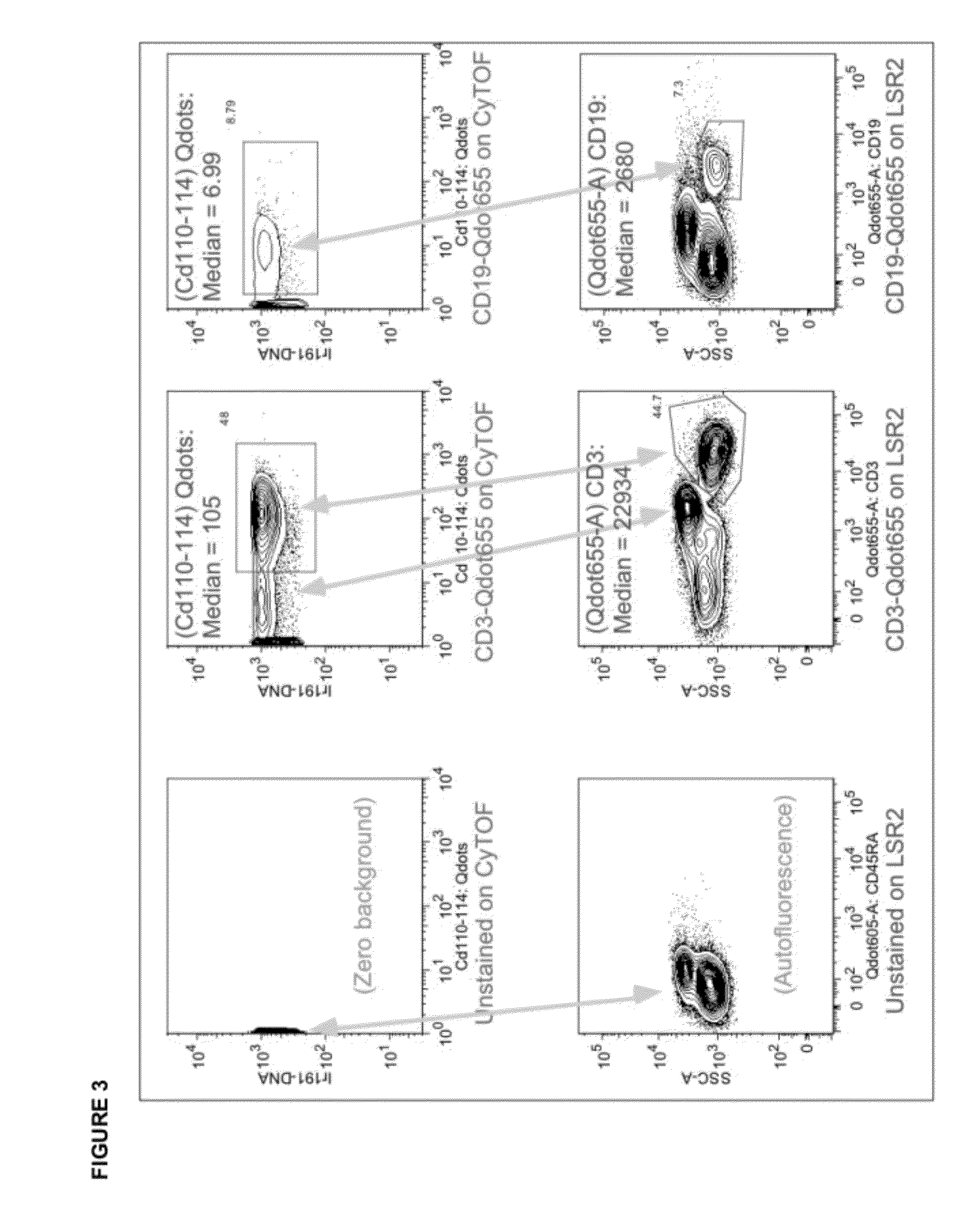Mass Dots: Nanoparticle Isotope Tags
- Summary
- Abstract
- Description
- Claims
- Application Information
AI Technical Summary
Benefits of technology
Problems solved by technology
Method used
Image
Examples
example 1
Quantitative Comparison of CyTOF and LSR2 Sensitivity to Qdot-Stained Cells
[0081]In order to assess the feasibility of applying nanoparticles to bioassays with atomic mass spectrometry detection we used commercially available quantum dots (QDots™) as a test material because they fall within the general physical requirements for mass dot applications. Non-isotopically-enriched Qdots were multiple cadmium channels. Quantum dots are nanocrystals primarily composed of the element cadmium doped small amounts of the element tellurium. By controlling the amount of dopant and the size of the quantum dot the fluorescent properties can be modulated—where larger quantum dots generally have longer emission wavelengths. Cadmium contains 8 stable mass isotopes between the atomic masses of 106 and 116. While not ideal, the signal for these particles was measured by monitoring the 6 most abundant isotopes. Also of not, if isotopically pure Qdots were available, they could potentially add 8 addition...
example 2
Preparation of 20 nm-Diameter, Chitosan-Impregnated EuF3 Nanocrystals
[0087]Combine:
VolumeConcentrationCompoundSource10 ml0.2M151EuCl398% enriched isotopeSigma25 ml1% w / v (in 0.05M HCl)Chitosan,Flukahighlyviscous10 ml0.12 mols (0.2222 gNH4FSigmain 10 mL water)
Titrate pH to 6.5 with dilute ammonia. React 2 hrs at 75*C. Nanocrystals will form spontaneously. Centrifuge to purify nanocrystals. Wash multiple times with deionized water with 0.5% v / v acetic acid. Nanocrystals can be stored in deionized water at this point. In 1 ml of phosphate buffered saline (PBS) react 1 mg of antibody with 0.4 mg of N-(3-dimethylaminopropyl)-N-ethylcarbodiimide hydrochloride (EDAC) and 0.6 mg N-hydroxysuccinimide (NHS) to conjugate. After 15 min add 4 mg of nanocrystals and react for 2 hrs at ambient temperature. Quench reaction by adding 0.2 mL of 1M glycine pH 8. Wash several times in PBS.
example 3
Preparation of 8 nm-Diameter, Oleic Acid-Impregnated LaF3 Nanocrystals
[0088]Combine:
VolumeConcentrationCompoundSource 1 ml0.5M139La(NO3)3Sigma 2 ml1.0MNaFSigma20 ml100%EthanolSigma1.2 ml 100%Deionized waterFisher10 ml100%Oleic AcidSigma
Stir the solution thoroughly until it becomes milky colloidal. Transfer it to a 50 mL Teflon lined autoclave and heat at 190*C for 6 h. Allow cooling to room temperature and collect the final product by means of centrifugation. Wash multiple times with ethanol to remove any possible remnants, and then dispersed in cyclohexane. At this point nano crystals could be functionalized with a photoreactive cross-linker. Alternatively, the carboxylic acid in the nanocrystal embedded oleic acid is reduced to an alcohol for further functionalized through treatment with a compound such as LiAlH under anhydrous conditions.
PUM
| Property | Measurement | Unit |
|---|---|---|
| Fraction | aaaaa | aaaaa |
| Fraction | aaaaa | aaaaa |
| Mass | aaaaa | aaaaa |
Abstract
Description
Claims
Application Information
 Login to View More
Login to View More - R&D
- Intellectual Property
- Life Sciences
- Materials
- Tech Scout
- Unparalleled Data Quality
- Higher Quality Content
- 60% Fewer Hallucinations
Browse by: Latest US Patents, China's latest patents, Technical Efficacy Thesaurus, Application Domain, Technology Topic, Popular Technical Reports.
© 2025 PatSnap. All rights reserved.Legal|Privacy policy|Modern Slavery Act Transparency Statement|Sitemap|About US| Contact US: help@patsnap.com



